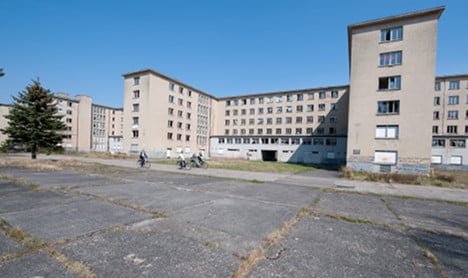The historic dormitory complex at Prora, built between 1936 and 1939, sprawls nearly five kilometres along a choice stretch of Baltic Sea coastline. This month, work began to turn one of the blocks into an upmarket hotel.
Built as one of the “Strength Through Joy” camps set up by the Nazis for the party faithful, it was to sleep up to 20,000 Germans in a pioneering attempt at mass tourism 300 kilometres north of Berlin.
The drive to offer recreation and hearty exercise was coupled with a desire to build loyalty and devotion to the Nazis among the working class, with ideological teaching on site.
The complex was to include a cinema, a theatre, a banquet hall for 25,000 people and two swimming pools. But World War II put an end to the scheme and work was never completed.
When the Soviet army seized control of eastern Germany at the end of the war, the camp was turned to military use and did not appear on travel maps.
Since the collapse of communist East Germany in 1989, the Prora complex sat desolate and largely empty, gradually deteriorating while the question of its future use remained unanswered.
The building is, alongside the Nazis’ Nuremberg party rally grounds, Germany’s most imposing architectural relic of the Third Reich.
But because of its size and state of disrepair, it had been a hard sell in the post-reunification years.
“After the fall of the Berlin Wall, following the brief stay of the German military here, we only had one idea in mind: sell the place,” said Sabine Sakuth, a guide at the Prora museum.
“From the start, there haven’t been any real plans for it. We don’t manage our heritage very well.”
Failing to find a buyer for the whole complex, the state has been forced to try to sell it piece by piece.
Very, very curious
Sakuth noted that part of the problem is financial – the disused concrete-block lodgings are crumbling and would-be investors are limited in what they can do with the white elephant, which is protected by rigid environmental and historical regulations.
And despite the valuable land the complex sits on being in one of Germany’s hottest tourist destinations, tearing it down is not an option.
“It is an issue that gives me a stomach ache,” admits local mayor Karsten Schneider.
Only one project thus far has got off the ground – last year a youth hostel with 400 beds opened in one section of the complex.
Two years of building work were necessary to make this still little-known place inviting, at a cost of €27 million, to which the European Union contributed development funds.
Now the spot welcomes students and families with children, even boasting wireless Internet, and 820 new windows look out onto the sea and the lush forest to the back of the complex.
“People are very, very curious and want to know what happened here – it’s great,” said Dennis Brosseit, who runs the youth hostel.
“A little like now, when you see young children running in the courtyards – it’s brilliant. Seeing this big block starting to live again is terrific.”
And in March, a Berlin investor forked out €2.75 million for one of the complex’s five blocks and plans to convert it into a hotel, spa and holiday apartment development, with work to start this month.
Local residents are sceptical about its prospects due to the recent explosion in holiday lodgings in the area.
“The Nazis wanted to have 20,000 beds here. I think with 3,000 beds we have already reached the limit,” Schneider, the mayor, said, adding that he would like to see a tourism institute or an oceanography academy instead of more hotel rooms.
AFP/jcw


 Please whitelist us to continue reading.
Please whitelist us to continue reading.
Member comments